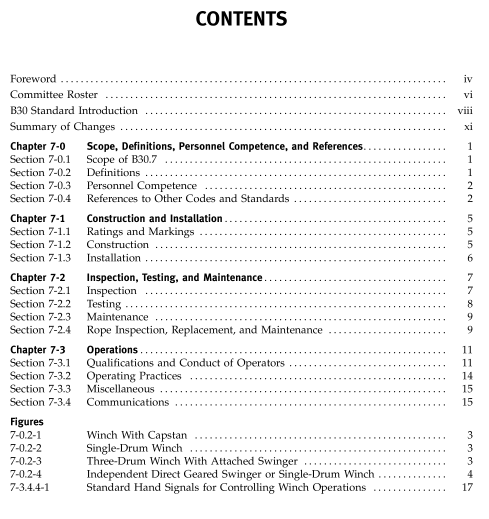ASME B30.7:2016 pdf download Winches Safety Standard for Cableways, Cranes, Derricks, Hoists, Hooks, Jacks, and Slings
SECTION 7-0.1:sCOPE OF B30.7
The B30.7 Volume includes provisions that apply tothe construction, installation, operation, inspection, test-ing, and maintenance of winches arranged for mountingon a foundation or other supporting structure for mov-ing loads. Winches addressed in this Volume are thosetypically used in industrial, construction, and maritimeapplications.The requirements included in this Volumeapply to winches that are powered by internal combus-tion engines, electric motors, compressed air, or hydrau-lics, and that utilize drums and rope.
This Volume does not apply to overhead hoists, minehoists, capstans, or winches installed as an integral partof the lifting system of other B30 equipment. Alsoexcluded are winches used with
(a) all-terrain-type recreational vehicles(b) drill rig relocation trucks
(c) tow trucks
(d) vehicle recovery units(e) boat trailers
(f) amusement park rides(g) excavating equipment
(h) equipment covered by ANSI A10,A17,A90,A92,A120,B20,B56, and B77 standards
(i) free-fall applications such as pile driving
Provisions of this Volume do not apply to the move-ment of personnel.
SECTION 7-0.2:DEFINITIONS
administrative or regulatory authority: governmentalagency, or the employer in the absence of governmentaljurisdiction.
brake: a device used for retarding or stopping motion.capstan (zoinch head): a rotatable cylindrical drum withcurved end flanges used for load handling by means offiber rope or wire rope with hand tension applied to thefree end of the fiber or the wire rope. A capstan maybe a stand-alone machine or may be installed as anauxiliary device on a winch (see Fig. 7-0.2-1).
clutch: a means for engagement or disengagement ofpower.
critical lift: a load handling operation that has been deter-mined to present an increased risk beyond normal loadhandling activities. For example, increased risk mayrelate to personnel injury, damage to property, interrup-tion of plant production, delays in schedule, release ofhazards to the environment, or other jobsite factors.drumm: the cylindrical member around which rope iswound for moving the load.
exposed: describes hazards not guarded or isolated (capa-ble of being contacted inadvertently).
final stage manufacturer: an entity that assembles, installs,or permanently affixes a winch to complete a load move-ment system.
jaw clutch: a clutch composed of two hubs with jawsthat engage each other. This type of clutch is eitherengaged or disengaged and cannot slip.
lifting/lowwering: vertical movement of a freely suspendedload by a winch.
limit device: a device that is activated by some part ormotion of a winch to stop drum rotation.
minimun breaking force: the minimum load at which anew and unused wire rope will break when loaded todestruction in tension.
operating conditions,nornal: conditions during which awinch is performing functions within the scope of itsoriginal design.
pawl (dog): a device for positively holding machineryagainst undesired motion.
qualified person: a person who, by possession of a recog-nized degree in an applicable field or certificate of pro-fessional standing, or who, by extensive knowledge,training, and experience, has successfully demonstratedthe ability to solve or resolve problems relating to thesubject matter and work.
ratchet: a toothed component for engagement with thepawl.
rated line pull: the manufacturer’s recommended load inpounds (kilograms) applied to the rope attachment onthe winch drum.
rated load: winch rating in pounds (kilograms) estab-lished by the manufacturer in accordance withSection 7-1.1.
rope: refers to wire rope unless otherwise specified.rotation-resistant rope: a wire rope consisting of an innerlayer of strands laid in one direction covered by a layerof strands laid in the opposite direction; this has theeffect of counteracting torque by reducing the tendencyof the finished rope to rotate.
service , heavy: service that involves operation within therated load limit but that exceeds normal service.
service ,nornmal: distributed service that involves opera-tion with randomly distributed loads within the ratedload limit, or uniform loads less than 65% of rated loadfor not more than 25% of the time.
service , severe: service that involves normal or heavy ser-vice with abnormal conditions.
shall: a word indicating a requirement.
should: a word indicating a recommendation.
spooling: winding of rope on a cylindrical drum inevenlyspaced wraps and uniform layers.
standby winch: a winch not in regular service but usedoccasionally or intermittently as required.
soinger drun: a drum that has a wire rope connectionpoint at each flange to allow an overwind andunderwind operation. When the rope is wrappedaround a derrick bull wheel, it is used to slew or swingthe derrick.
seoitch: a device for making, breaking, or changing theconnections in an electric, hydraulic, or pneumatic cir-cuit (valve).
zsinch: a power-driven drum(s) that when attached to aload is capable of moving the load (see Figs. 7-0.2-1through 7-0.2-4).
